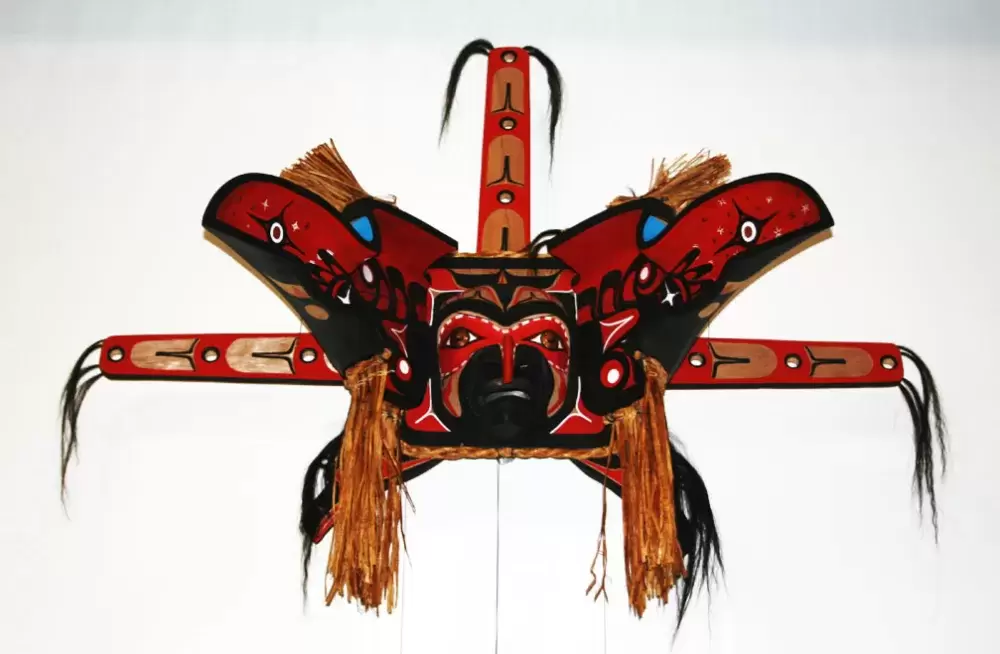When a dream is sent out into the universe, it often doesn’t take too long to be realized. That seems to be what happened to Qwaya Sam, an Ahousaht artist now living in Campbell River.
Fellow artist George Hunt, Jr. would visit Sam’s work studio to sit to carve and talk. One day Sam told Hunt that he would like to carve a transformation mask. ‘Well, one day you will,’ Hunt told his friend.
Three weeks later, Sam received a phone call from Patricia McAuley, then the principal of Haahuupayak School on Tseshaht territory near Port Alberni. The school had received funding from the Canada Council for the Arts for a project called “Carving For Our Future.” McAuley wondered if Sam wanted to take part.
The project got underway around this time last year, and one of the results of Sam’s work was unveiled at the school yesterday afternoon, Oct. 26.
The legend of how Raven placed the sun in the sky was the inspiration for Sam’s transformation mask, installed in the main hall at the school and revealed to the student population in a ceremony.
Sam performed a prayer chant and Hunt removed the cloth that covered the mask hanging on a wall. Raven peered out at the students. Later, the mask would be opened to reveal the Sun carving inside. The students’ ‘oohs’ and ‘ahs’ demonstrated their appreciation of the work.
Hunt, a renowned carver from Kwagiulth territory with roots in Friendly Cove, joined Sam, Stephen Lucas of Hesquiaht, and Louie Johnson of Mowachaht to sing two songs. The first was a love song that was given to Sam’s father and uncle in 1989 at a potlatch in Neah Bay, Wash. where the family’s 88-year-old grandmother lived. Cut off from her Ahousaht family in Canada, she sent a messenger to invite them to the potlatch. There they were stood up and the song was sung to them.
The second song was from Hesquiaht, sung to honor the memory of Sam’s late brother Lance Ambrose, who passed away in June. The project was supposed to have been done by that time, but the difficulties the family were going through as Ambrose battled illness delayed the carving’s completion.
As part of the project, Sam’s role was to sit in the main hall of the school and talk with the students about Nuu-chah-nulth history, culture, customs and traditions, including carving. On many occasions, Ambrose would visit his brother Qwaya at the school, putting his hands on the paddles that Sam was making for the elementary school’s graduating class, and the mask that Sam was carving.
Sam said the carving project allowed him time with his brother, and that energy is in the mask. Sam said he was glad the mask was in a place where he could visit it.
While Sam had worked with other artists on making transformation masks, this was his first official mask made by his own hand. Sam secured the help of Hunt from time to time for discussion on the project’s progress.
Hunt described himself as the ‘hired gun’ of the project. He had experience with such complicated carvings and was able to put “his signature” in some elements of the piece. But while Hunt had input into the work, he stressed that the mask, from concept to completion, was Sam’s all the way.
In his speech to the students, he thanked them for the opportunity to come back to an area where he feels such a strong connection to the Nuu-chah-nulth. His grandmother was Emma Hunt, nee Billy. Her grandson said Emma would be very proud that the culture was being passed along to the younger ones.
“Days like this,” George said, “reminds me to keep going forward.”
He said carvers live for the day that they can create, and their histories, culture and language echo out from the cedar trees to them. Hunt thanked Sam for allowing him to be part of the project.
John Rampanen, Naas-a-thluk, which means Takes Care of the Day, is a member of the haahuupayak school board. He wrote the application to the Canada Council for the project grant. He described the school as an inspirational, beautiful place for students to learn. What was missing was the smell of cedar, he said, and Sam’s work in the school brought the smell of cedar, and the Nuu-chah-nulth culture being practiced, into the school.
Naas-a-thluk said it was fitting that a work that came from the project was a transformation mask, because that’s what is happening in haahuupayak school. He said Nuu-chah-nulth become stronger with every generation removed from the residential school experience of the past.
To show their appreciation to the artists, the students of Haahuupayak stood to sing a song that has become an anthem at the school. The song came from Doug Robinson, who gave it to the Tseshaht band to use, who, in turn, allowed the song to be used in the school, said Nuu-chah-nulth Studies teacher Trevor Little. The children sing it every morning before the school day begins, Little added.
New principal Kailee Carr smiled broadly while the children were singing. She said she had never heard them sing so strongly before.
“I got goose-bumps,” she said.
Carr thanked the artists, Rampanen and McAuley for the work they did to make “Carving For Our Future” a reality.
Sam said the day was filled with mixed emotions for him. While he was glad the work was done and in its home at Haahuupayak, it filled him with emotion because of the memories of his brother that are in the mask. He said it taught him a good lesson: When you are experiencing difficulties, you get up and continue on.







